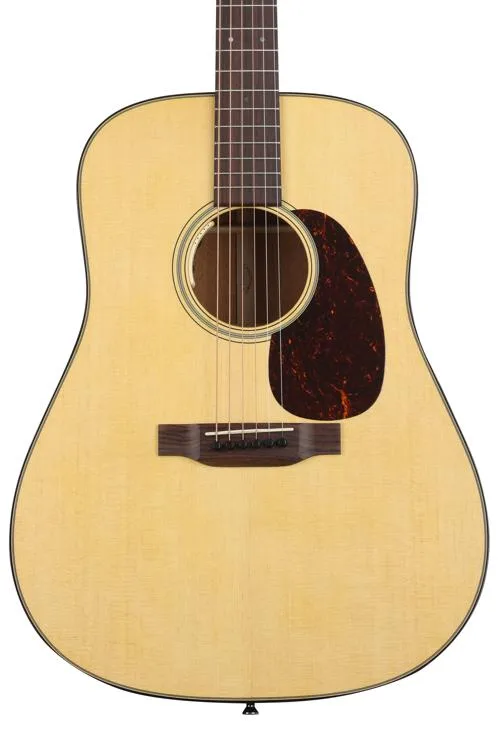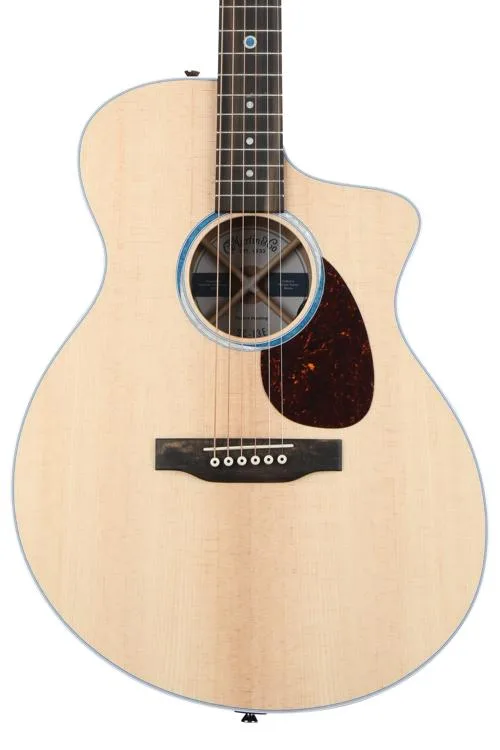Any guitarist is likely already familiar with the Martin brand. Any Martin acoustic is a guitar to be proud of, but the Martin D-35 is truly a work of art. It's often considered to be the ultimate dreadnought acoustic guitar. If you're ready to invest in a remarkable instrument with great tone, the D-35 is a great choice.
Things To Consider Before Buying A Martin Guitar
Any Martin guitar is an investment. If you're ready to invest in a guitar like the D-35, it's a good idea to think carefully about what you want in a Martin. Here are some of the things to consider before making a purchase:
At A Glance: Martin D-35 & Its Alternatives
- Our Top Pick: Martin D-35 Guitar
- Alternate Choice 1: Gibson J-45 Standard
- Alternate Choice 2: Martin D-18E
- Alternate Choice 3: Martin SC-13E
| IMAGE | PRODUCT | |
|---|---|---|
Our Top Pick  |
| VIEW ON SWEETWATER →VIEW ON AMAZON → |
Alternate Choice 1  |
| VIEW ON SWEETWATER → |
Alternate Choice 2  |
| VIEW ON SWEETWATER →VIEW ON AMAZON → |
Alternate Choice 3  |
| VIEW ON SWEETWATER → |
Our Picks for Review
Martin D-35 Guitar
PRO's & CON's of Martin D-35
Before we jump into our Martin D-35 dreadnought acoustic guitar review, let's check out a few pros and cons:

Pros
Cons
Features and Benefits
Tonewoods
Like most Martin acoustic guitars, this one is a dreadnought. This body shape is extremely versatile, and it produces both enough power and enough nuance for most musical genres. However, the tonewoods used to build a guitar have a significant effect on the quality of its sound.
The D-35 is made with the classic tonewood configuration of solid Sitka spruce and solid East Indian rosewood. It's signature three-piece East Indian rosewood back is often found on high-end Martins. The Sitka spruce soundboard offers a warm sound that's a bit brighter than most soundboard materials, and the East Indian rosewood back and sides help to round out the tone. The East Indian Rosewood is a rare and somewhat expensive wood, but it produces impressive clarity in both bass and treble frequencies. This video offers an informative comparison of rosewood, mahogany, and maple, which are all commonly used for the backs and sides of guitars.
The D-35 also has a stunning ebony fingerboard. Thanks to its natural oiliness and tight grain, ebony is a fingerboard material that maintains a slick feel and remains highly playable. Like some higher-end acoustics, this one's neck has antique white binding. The binding offers a striking contrast against the wood of the fingerboard. The neck, which is made of select hardwoods, has Martin's acclaimed modified low oval profile with a high-performance taper. This profile makes it a faster-playing neck than you'll find on most dreadnought acoustic guitars--if you primarily play electric, you might find this guitar to be a smoother transition.
Bracing And Sound Quality
Bracing also is crucial when it comes to shaping tone. The Martin D-35 is made with forward-shifted X bracing that isn't scalloped. Forward-shifted bracing is used on some Martin models (this video compares the different bracing positions used on Martin instruments). By moving the "X" in the bracing forward, this style frees up more of the soundboard to vibrate. The result is the tone that's often noticeably louder, and many players often notice an increase in low-end frequencies. The bracing isn't scalloped--some players prefer the sound of scalloped bracing, which takes some of the focus off of the midrange, but others prefer the more even tone of non-scalloped. Of course, the best way to see if a given sound is for you is to listen to the guitar in question. This video demo lets you hear the Martin D-35 dreadnought being played.
Appearance And Finish Options
Any devotee of Martin guitars knows that these instruments aren't flashy--they don't have large abalone inlays, ornate rosettes, or exceptional finishes on the classic Sitka spruce top. However, the artistic touches of the D-35 make this a genuinely timeless instrument. The antiqued white binding and delicate, understated fingerboard inlays complement its flawless finish, and the chrome tuning machines give it a slightly more modern look compared to many of Martin's flagship model.
The finish itself isn't the most critical part of a guitar, but Martin's finishing process is a unique one that ensures its instruments stand out for decades to come. This video explains what makes the company's finishes so unique.
If you think this is the next guitar you want to add to your collection, the good news is that there are a few different colours to choose from. Because of the care that goes into the finishing process of the top of each guitar, some are more expensive than others:
Social Proof of the Guitar
It's usually wise to try out a guitar in person before buying, but this is not always possible. We've found a few reviews of the Martin D-35 to help you make a decision.

This review helps explain how the non-scalloped bracing of the D-35 creates its brilliantly resonant tone. Just like the writers of almost all the reviews we found, this person was pleased with the D-35.

This Martin D-35 review is primarily useful, as this reviewer has played several other Martins and can compare them to the D-35. Any Martin is a quality guitar, but this one has earned a distinguished reputation.

Before settling on the D-35, it's a good idea to consider other guitar options that may be a good fit for you. Here are three possible alternatives:
Alternatives to Martin D-35
Before settling on the D-35, it's a good idea to consider other guitar options that may be a good fit for you. Here are three possible alternatives:
Gibson J-45 Standard
How it Compares to Martin D-35

Review
The Gibson J-45 is one of Gibson's flagship models, just as the Martin D-35 is one of Martin's. This guitar is a slope-shouldered dreadnought acoustic guitar. Like the D-35, it has a solid Sitka spruce top, but the back is solid mahogany, which gives it a darker, warmer sound. The J-45 also comes with the L.R. Baggs VTC pickup system.
If you like the D-35 but want a quality guitar that also comes with electronics, make sure you check this one out!
Martin D-18E
How it Compares to Martin D-35

Review
While classic Martin acoustics often don't come with electronics, the brand has been trending toward making more acoustic-electric models. The D-18E looks like a classic Martin dreadnought, but it comes with L.R. Baggs electronics. In terms of build, it's similar to the Martin D-35. It has a top of Sitka spruce, mahogany back and sides, and a mahogany neck.
Mahogany has a distinctively different sound compared to East Indian rosewood, but depending on your preferences, it may be a better choice for you. If you like the D-35 but want an acoustic-electric Martin, make sure you check out this guitar!
Martin SC-13E
How it Compares to Martin D-35

Review
This guitar is one of the few Martin acoustics that's not a dreadnought--it has a unique shape that is a bit like a grand auditorium. The SC-13E is an affordable alternative to the D-35, and it comes with Fishman MXT electronics. It has a top of Sitka spruce and laminated koa back and sides, and its slim neck and comfortable body are ideal for performers.
The fingerboard is tastefully accented with celestial blue inlays. If you're looking for a less expensive guitar and prefer a modern aesthetic, make sure you check this one out!
In Conclusion
If you're looking for the pinnacle of Martin guitars, the D-35 is it. From the vintage-inspired binding to the flawless finish to the balanced and articulate Martin sound, this is a guitar for the discerning player. While this guitar is more expensive than many, it's a worthy investment for players of almost any genre. Click here to check it out!



